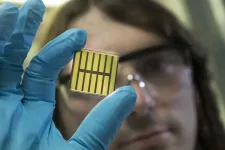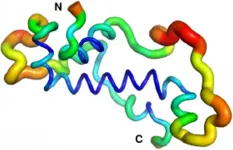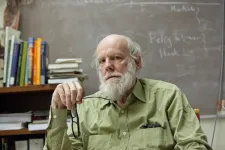Shedding light on perovskite films
Efficient materials for future solar cells - New model to determine photoluminescence quantum efficiency
2021-03-12
(Press-News.org) Photovoltaics decisively contributes to sustainable energy supply. The efficiency of solar cells in directly converting light energy into electrical energy depends on the material used. Metal-halide perovskites are considered very promising materials for solar cells of the next generation. With these semiconductors named after their special crystal structure, a considerable increase in efficiency was achieved in the past years. Meanwhile, perovskite solar cells have reached an efficiency of up to 25.5 percent, which is quite close to that of silicon solar cells that are presently dominating the market. Moreover, the materials needed for perovskite solar cells are rather abundant. The solar cells can be produced easily and at low cost and they can be used for various applications. The theoretically achievable efficiency of perovskite solar cells is about 30.5 percent.
To approach this value, optoelectronic quality of perovskite semiconductors must be further increased. In principle, materials suited for photovoltaics are expected to not only absorb light, but to also emit it efficiently. This process is known as photoluminescence. The corresponding parameter, photoluminescence quantum efficiency, is perfectly suited to determine the quality of perovskite semiconductors. Together with scientists from the Center for Advanced Materials (CAM) of Heidelberg University and the Technical University of Dresden, researchers of KIT's Institute of Microstructure Technology (IMT) and Light Technology Institute (LTI) have now developed a model, by means of which photoluminescence quantum efficiency of perovskite films can be determined reliably and exactly for the first time. Their results are reported in Matter.
Materials Have More Optimization Potentials than Assumed
"With the help of our model, photoluminescence quantum efficiency under solar irradiation can be determined far more precisely," says Dr. Paul Fassl from IMT. "Photon recycling is of high importance. This is the share of photons emitted by the perovskite, which is re-absorbed and re-emitted in the thin films." The researchers applied their model to methylammonium lead triiodide (CH3NH3PbI3), one of the perovskites of highest photoluminescence quantum efficiency. So far, it has been estimated to amount to about 90 percent. Model calculations, however, revealed that it is about 78 percent. The scientists explain that previous estimations did not adequately consider the effect of light scattering and, hence, underestimated the probability of photons - the quantums of light energy - leaving the film before they are re-absorbed. "Our results show that the potential for optimization of these materials is far higher than assumed," says Dr. Ulrich W. Paetzold, Head of the Advanced Optics and Materials for Next Generation Photovoltaics Group of IMT. The team offers an open-source application based on the model, by means of which photoluminescence quantum efficiencies of various perovskite materials can be calculated.
INFORMATION:
Original Publication
Paul Fassl, Vincent Lami, Felix J. Berger, Lukas M. Falk, Jana Zaumseil, Bryce S. Richards, Ian A. Howard, Yana Vaynzof, Ulrich W. Paetzold: Revealing the internal luminescence quantum efficiency of perovskite films via accurate quantification of photon recycling. Matter. Cell Press, 2021. DOI: 10.1016/j.matt.2021.01.019.
https://authors.elsevier.com/a/1cbg49CyxcxO47
More about the KIT Energy Center: https://www.energy.kit.edu/
Contact for This Press Release
Sandra Wiebe, Press Officer, Phone: +49 721 608-41172, Email: sandra.wiebe@kit.edu
Being "The Research University in the Helmholtz-Association," KIT creates and imparts knowledge for the society and the environment. It is the objective to make significant contributions to the global challenges in the fields of energy, mobility and information. For this, about 9,600 employees cooperate in a broad range of disciplines in natural sciences, engineering sciences, economics, and the humanities and social sciences. KIT prepares its 23,300 students for responsible tasks in society, industry, and science by offering research-based study programs. Innovation efforts at KIT build a bridge between important scientific findings and their application for the benefit of society, economic prosperity, and the preservation of our natural basis of life. KIT is one of the German universities of excellence.
[Attachments] See images for this press release:

ELSE PRESS RELEASES FROM THIS DATE:
2021-03-12
Proteins are the key component in all modern forms of life. Haemoglobin, for example, transports the oxygen in our blood; photosynthesis proteins in the leaves of plants convert sunlight into energy; and fungal enzymes help us to brew beer and bake bread. Researchers have long been examining the question of how proteins mutate or come into existence in the course of millennia. That completely new proteins - and, with them, new properties - can emerge practically out of nothing, was inconceivable for decades, in line with what the Greek philosopher Parmenides said: "Nothing can emerge from nothing" (ex nihilo nihil fit). Working with colleagues from the USA and ...
2021-03-12
The Cabeza de los Gatos waste rock pile, left from mining activities in the town of Tharsis (Huelva), underwent a rehabilitation process consisting of remodelling the slope of the pile, applying liming materials and then a layer of soil. Finally, trees and shrubs typical of the area were planted and a hydroseeding with a mixture of shrub and herbaceous seeds was applied. Twelve years later, a study led by researchers from IRNAS-CSIC, in collaboration with Sabina Rossini Oliva, a researcher from the University of Seville and the Environment and Water Agency of Andalusia (AMAYA), has proven the effectiveness of this sort of rehabilitation.
"The results obtained show that the steps taken were successful. Now, ...
2021-03-12
People with high levels of emotional intelligence are less likely to be susceptible to 'fake news', according to research at the University of Strathclyde.
The study invited participants to read a series of news items on social media and to ascertain whether they were real or fictitious, briefly describing the reasons for their answers. They were also asked to complete a test to determine their levels of emotional intelligence (EQ or emotional quotient) and were asked a number of questions when considering the veracity of each news item.
Researchers found that those who identified the types of news correctly were most likely to score highly in the EQ tests. There was a similar correlation between correct identification and educational attainment.
The ...
2021-03-12
In asthma, the airways become hyperresponsive. Researchers from Uppsala University have found a new mechanism that contributes to, and explains, airway hyperresponsiveness. The results are published in the scientific journal Allergy.
Some 10 per cent of Sweden's population suffer from asthma. In asthmatics, the airways are hyperresponsive (overreactive) to various types of stimuli, such as cold air, physical exertion and chemicals. The airways become constricted, making breathing difficult.
To diagnose asthma, a "methacholine test" is commonly used to determine whether a person is showing signs of airway hyperresponsiveness. Methacholine binds to what are known as muscarinic receptors in the smooth muscle cells lining the inside ...
2021-03-12
The researchers say this is a big step in tackling smouldering peat fires, which are the largest fires on Earth. They ignite very easily, are notoriously difficult to put out, and release up to 100 times more carbon into the atmosphere than flaming fires, contributing to climate change.
The fires, known as 'zombie fires' for their ability to hide and smoulder underground and then reanimate as new flames days or weeks after the wildfire had been extinguished, are prevalent in regions like Southeast Asia, North America, and Siberia.
They are driven by the burning of soils rich in organic content like peat, which is a large natural reservoir of carbon. Worldwide, peat fires account for millions of tonnes of carbon released into the atmosphere each year.
Firefighters currently use millions ...
2021-03-12
A new model of aging takes into account not only genetics and environmental exposures but also the tiny changes that randomly arise at the cellular level.
University Professor Caleb Finch introduced the "Tripartite Phenotype of Aging" as a new conceptual model that addresses why lifespan varies so much, even among human identical twins who share the same genes. Only about 10 to 35 percent of longevity can be traced to genes inherited from our parents, Finch mentioned.
Finch authored the paper introducing the model with one of his former graduate students, Amin Haghani, who received his PhD in the Biology of Aging from the USC ...
2021-03-12
Researchers at Lund University in Sweden can now show that a new examination method identifies high-risk plaques in the blood vessels surrounding the heart, that cannot be seen solely with traditional angiograms. This type of plaque, rich in fat, could potentially cause recurring heart attacks in patients with heart disease. The study is published in the The Lancet.
"We have been working on this study for ten years. This creates a unique opportunity to treat plaques before they cause a heart attack", says David Erlinge, professor of cardiology at Lund University and Consultant in ...
2021-03-12
During 1995-2015, fullerene derivatives had been the dominating electron acceptors in organic solar cells (OSCs) owing to their performance superior to other acceptors. However, the drawbacks of fullerenes, such as weak visible absorption, limited tunability of electronic properties and morphological instability, restrict further development of OSCs toward higher efficiencies and practical applications. Therefore, the development of new acceptors beyond fullerenes is urgent in the field of OSCs.
Professor Zhan Xiaowei from the College of Engineering at Peking University is one of the pioneers engaging in development of nonfullerene acceptors in the world. ...
2021-03-12
University of Otago researchers have discovered one of the reasons why more than 50 per cent of people with type 2 diabetes die from heart disease.
And perhaps more significantly, they have found how to treat it.
Associate Professor Rajesh Katare, of the Department of Physiology, says it has been known that stem cells in the heart of diabetic patients are impaired. While stem cell therapy has proved effective in treating heart disease, it is not the case in diabetic hearts.
It has not been known why; until now.
It comes down to tiny molecules called microRNA which control gene expression.
"Based on the results of laboratory testing, ...
2021-03-12
New bioarchaeological research shows malaria has threatened human communities for more than 7000 years, earlier than when the onset of farming was thought to have sparked its devastating arrival.
Lead author Dr Melandri Vlok from the Department of Anatomy, University of Otago, says this ground-breaking research, published today in Scientific Reports, changes the entire understanding of the relationship humans have had with malaria, still one of the deadliest diseases in the world.
"Until now we've believed malaria became a global threat to humans when we turned to farming, but our research shows in at least Southeast Asia this disease was a threat to human groups well before that.
"This research providing a new cornerstone of malaria's evolution with humans is a great achievement ...
LAST 30 PRESS RELEASES:
[Press-News.org] Shedding light on perovskite films
Efficient materials for future solar cells - New model to determine photoluminescence quantum efficiency




